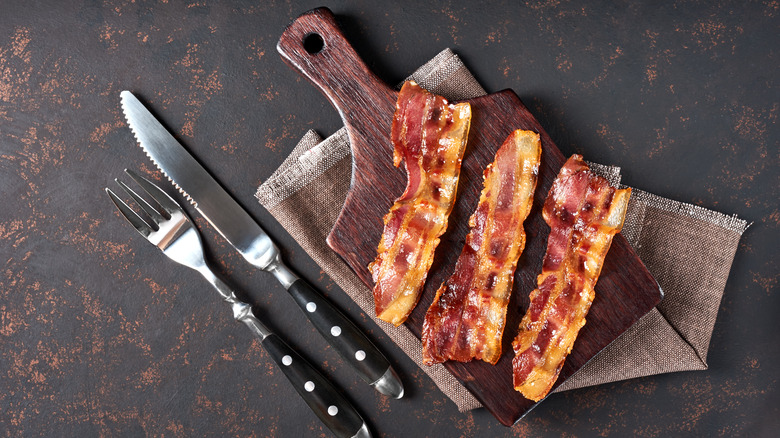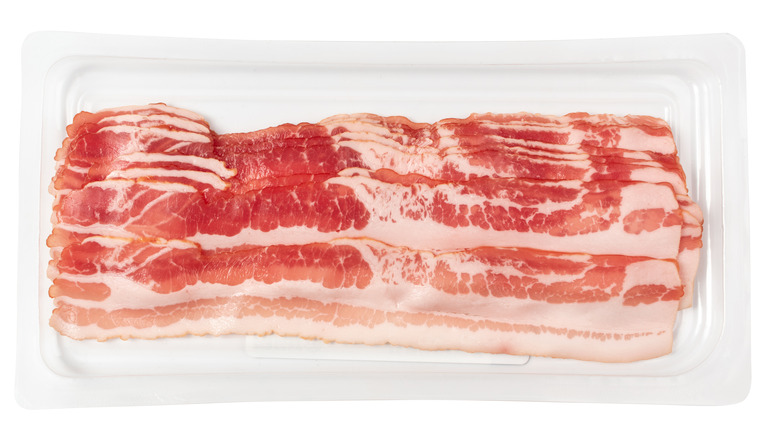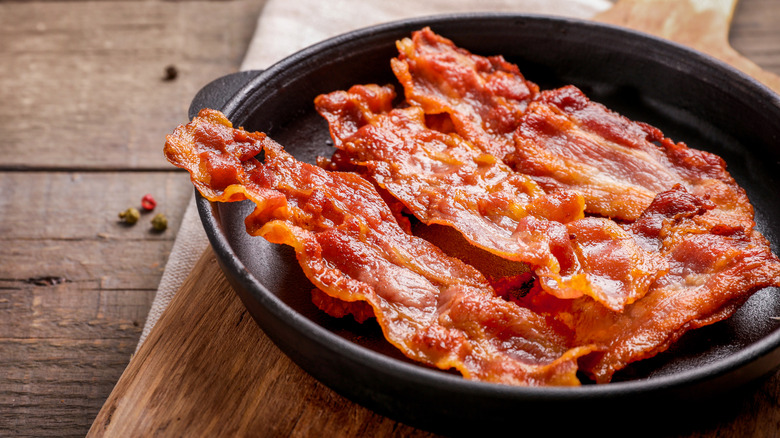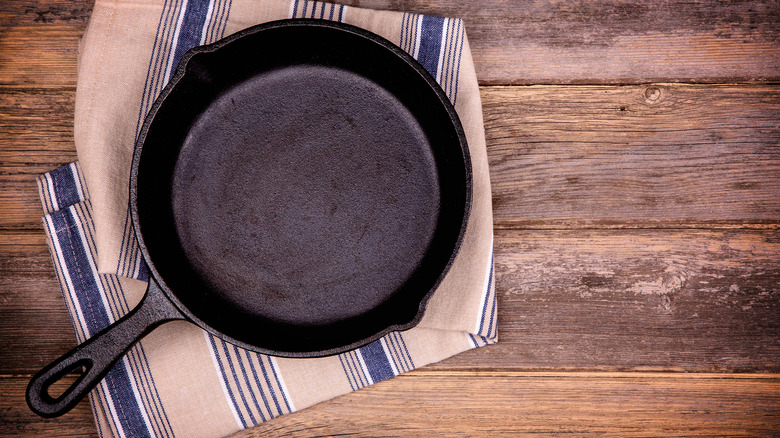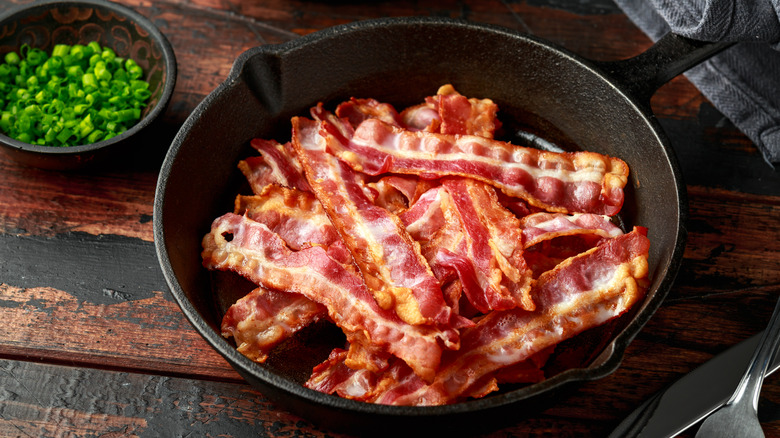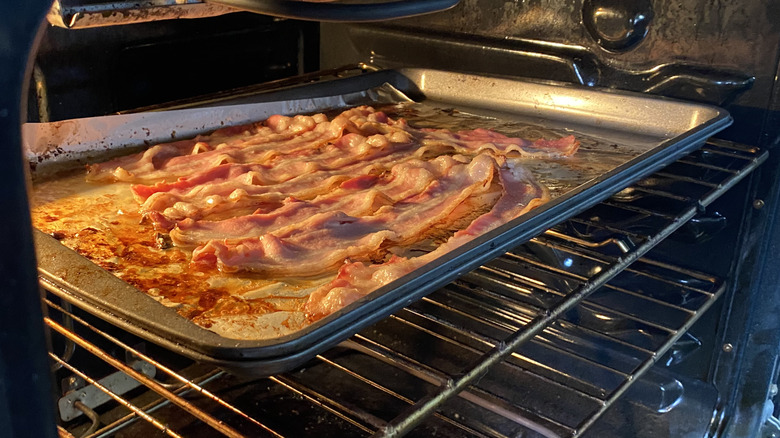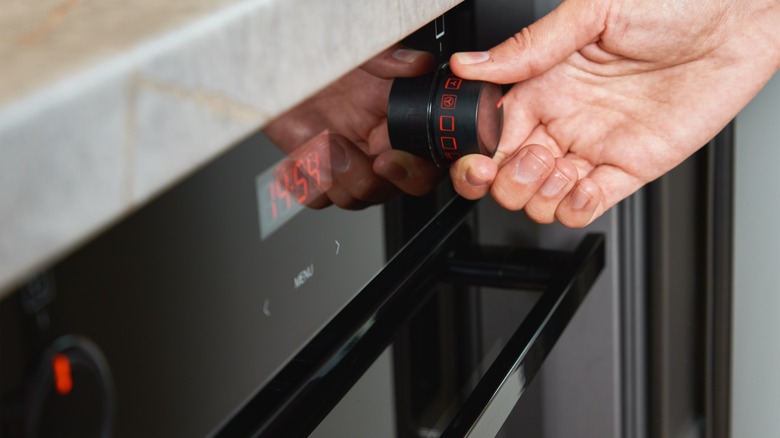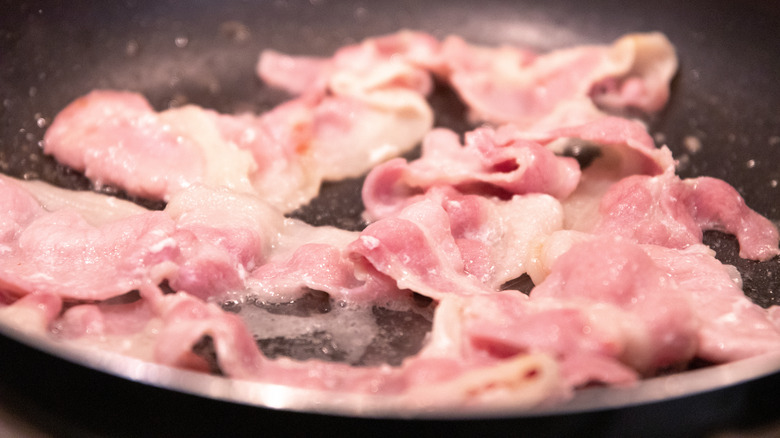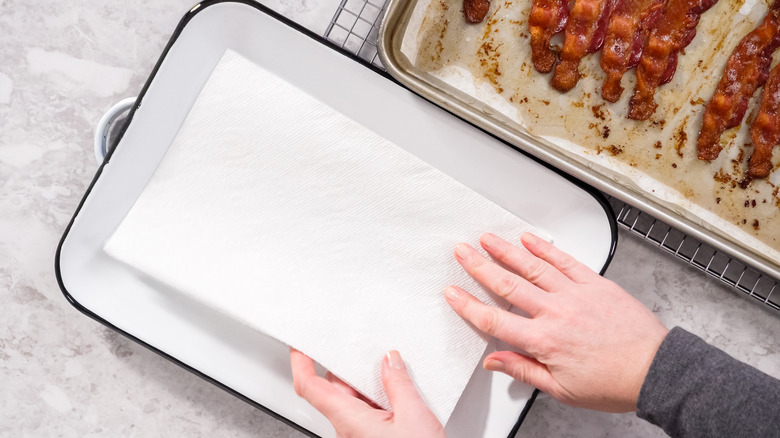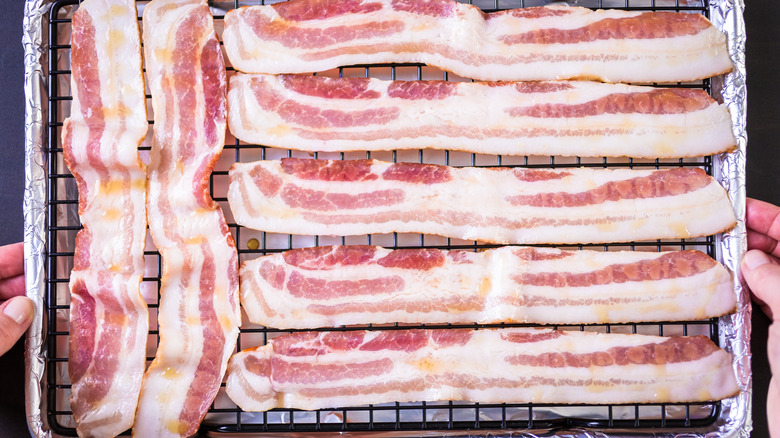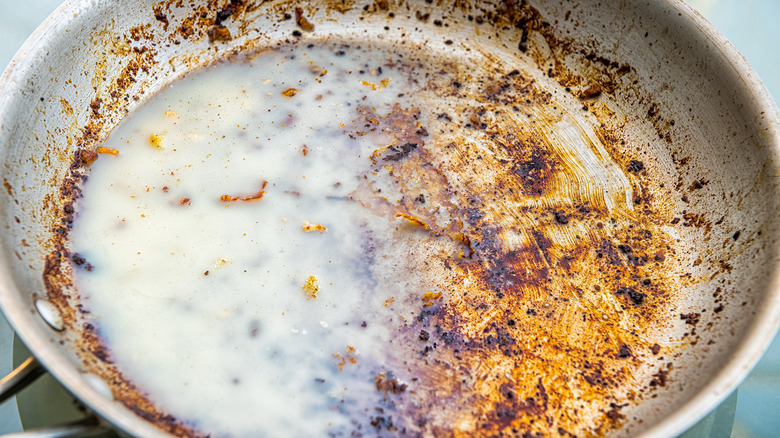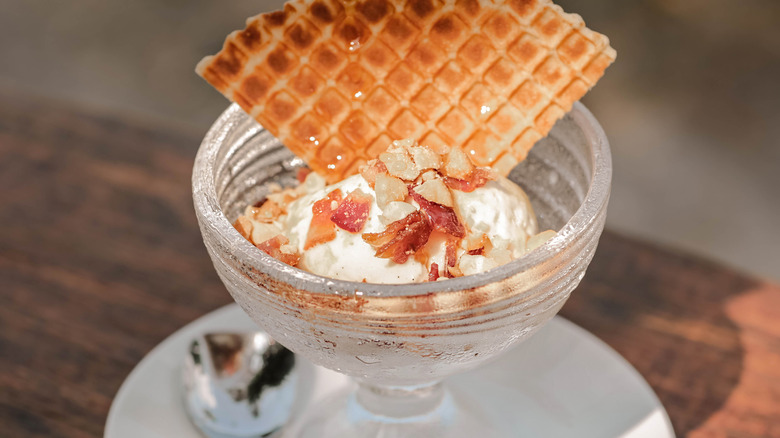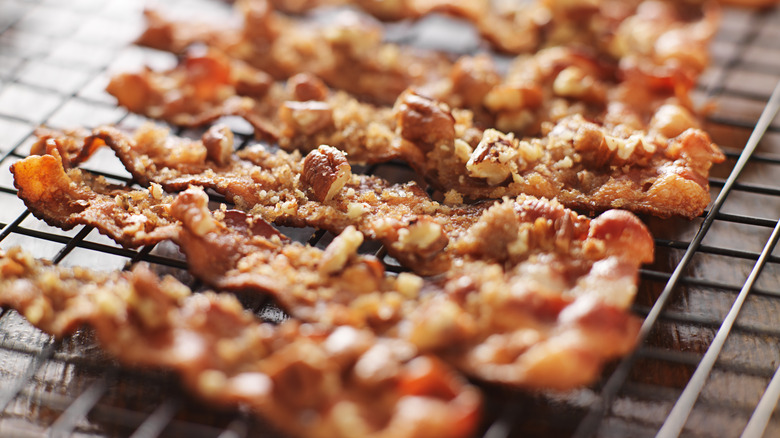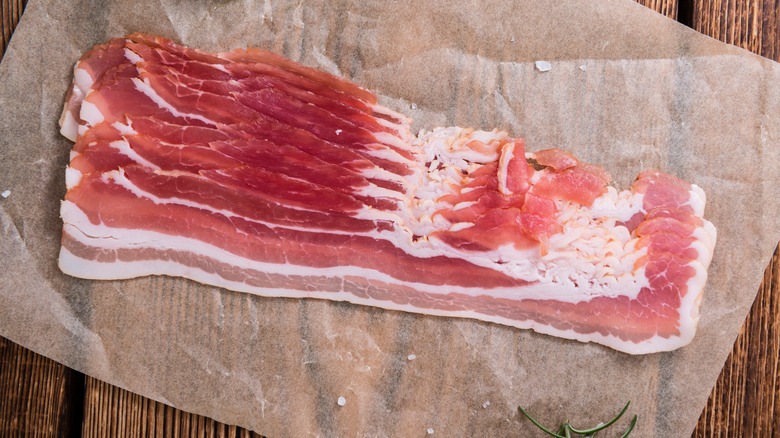Every Way You're Ruining Bacon
When it comes to foods with a cult-like following, few are as universally loved as bacon. More than any other cut of meat, bacon is the perfect marriage of crispiness and saltiness, instantly elevating any breakfast, sandwich, or baked potato. Cooking bacon seems easy enough: Heat up your frying pan, toss a few strips in, and let them sizzle until ready. But along the way, you will encounter a number of pitfalls most amateur home cooks make on a regular basis.
It is worth taking the time to learn how to properly cook bacon, as it can be used in a number of ways beyond simply tossing a few strips next to your scrambled eggs. From choosing the right cut to preparing your tools so they work optimally, you are going to want to make sure you have crossed all of your t's and dotted all of your i's. The next time you head to the grocery store and pick up a pound of bacon, make sure you have reviewed these common mistakes to avoid ruining the batch.
Choosing the wrong bacon at the store
The very first mistake people tend to make when cooking bacon happens before they even step out of the grocery store. As with many other food items, choosing higher-quality ingredients can make a huge difference, and it is totally worth paying a couple of extra dollars for a better product. In particular, grocery store bacon can vary across a range of qualities, so it's important to choose something decent.
Eat Like No One Else blog recommends shopping for center-cut bacon and skipping pre-packaged options altogether. Instead, shop directly from the butcher counter to ensure you are purchasing the freshest meat possible. This precaution should result in a better meal overall.
If you must buy packaged bacon, there are a few aspects to consider to optimize your purchase. Consider thick-cut bacon that won't burn after just a couple of minutes in the frying pan, or try out different flavors like hickory smoked, applewood, cherrywood, or even jalapeño.
Heating the bacon from cold
We understand the eagerness of opening the fridge in the morning and realizing there's a package of bacon just waiting to be cooked for breakfast. But a crucial mistake to avoid is simply throwing cold bacon into a frying pan. The fast-acting change in temperature from cold to extremely hot will cause your bacon to shrink, resulting in less bacon than you bargained for — nobody wants that.
Instead, you should let your bacon sit at room temperature for a period of time before you actually begin cooking. Take it out of the refrigerator, make yourself a cup of coffee, take the dog out, and it should be ready to go. If you want to speed it along, simply run the package of cold bacon under room temperature water to remove the chill a little quicker. Either way, make sure that you are not throwing cold bacon into a hot pan unless you want it to be truly bite-sized.
Heating up your pan too high
The temperature at which we cook our food can have a much bigger impact on the final results than we may realize. You've probably heard the phrase low and slow when referring to the best way to cook certain foods, from scrambled eggs to grilled cheese. Bacon follows the same pattern, so you'll want to avoid turning your stove top burner on too high.
A searing hot pan will cook the bacon fat far too quickly, preventing the middle from cooking properly. You'll be left with a less-than-optimal texture and total remorse for ruining what could have otherwise been a tasty plate of bacon.
To avoid this catastrophe, one Redditor starts with a cold pan and heats the stove top when the bacon is already in the pan. This may be a bit longer but the fat will have the proper amount of time to melt so the rest of the bacon can crisp nicely. Life Hacker also points out that this method will yield more bacon grease, which is an excellent source of cooking fat.
Using a low-quality pan or sheet
The right ingredients are not the only elements you should be concerned about when whipping up a great breakfast. You will also want to make sure you are using the best tools possible, which include your frying pans, baking sheets, and other gadgets specifically designed to produce the tastiest plate of bacon.
To ensure bacon cooks evenly, a heavy-bottom pan such as a cast iron skillet is best if you are cooking on the stove top. BENSA (a community of bacon enthusiasts) recommends using a larger pan that can cook multiple strips of bacon at the same time. GQ also suggests picking up a bacon press and using it in order to keep your bacon flat and cooking evenly.
If you are cooking bacon in the oven, consider using two baking sheets instead of one. Sandwiching the bacon between the sheets will also help prevent the strips from curling. Using low-quality substitutes for any of these products may result in bacon that is cooked unevenly, which is worth avoiding.
Cooking in a pan instead of the stove
One of the most satisfying sounds in the culinary world has got to be the sizzle of bacon while it is cooking. Not to mention the fact that cooking bacon in a frying pan fills your kitchen with that oh-so-wonderful breakfast aroma. But those two sensory experiences aside, cooking bacon in a frying pan is messy, at times potentially dangerous, and not quite efficient if you are cooking for multiple people.
The simple solution here is to switch over to oven-baked bacon, which is superior to pan frying for a number of reasons. For starters, it's cleaner: You do not have to deal with bacon grease flying all over the place, not to mention you don't need to worry about being attacked by boiling hot droplets of grease leaping out of the pan.
Using the oven is also more effective when cooking for multiple people, as a baking sheet can hold a greater amount of bacon than pretty much any pan. Since you cannot see your bacon as it cooks in the oven, however, it may require some trial and error to get the timing right — give 13 to 15 minutes at 350 F a try.
Turning the heat too high
Granted, cooking bacon in the oven is much more convenient if you're preparing food for a crowd, not to mention the fact that it is less messy overall. However, this method has just as many potential land mines as cooking it in a frying pan, and you will need to be aware of the possible issues in order to avoid burning your bacon.
Bacon cooks relatively fast in the oven; you only need a little over 10 minutes or so if the oven is at 350 to 400 F. However, you should not heat your oven any higher than that. If 400 F seems dicey, you can absolutely use the low and slow method by turning the oven down to 350 or even 325 and adjusting the timer accordingly. Since you will not be able to watch the meat as closely when it is baking in the oven, not to mention the fact that every oven is different, you will want to try a few rounds to determine the best temperature and timing combination.
Neglecting to add water to your pan
It can be harder than you might think to achieve the perfect amount of crispness when cooking bacon. Far too often, we find ourselves falling on the undercooked or overcooked sides of the scale. Thankfully, there are several tricks you can pull out of your sleeve to make sure you get the crispiest strips of bacon possible. In fact, some cooks consider this particular strategy an absolute must, and you are making a major error if you do not follow this step.
The next time you make bacon in the frying pan, add water. According to America's Test Kitchen, adding enough water to submerge bacon in the frying pan helps the fat render without burning the meat. This method takes a little more time than tossing bacon directly into a frying pan, but once you give it a try, you may decide to stick with this method moving forward.
Not using paper towels to avoid smoking
When we want to improve our culinary skills and take our cooking to the next level, we often look to celebrity chefs and television personalities to guide us toward being the best home chef we can be. Food Network star Alton Brown may be known for hosting shows, but he also knows his way around the kitchen, and he has a tip for everyone to keep in mind to reduce smoke when cooking bacon in the oven.
Brown shared his strategy on Twitter, which involves three tools: a baking sheet, a wire cooling rack, and paper towels. Place your strips of bacon on the wire rack and layer paper towels over the baking sheet. Then, assemble the wire rack over the baking sheet to catch the drippings. Note that you do not want to heat your oven higher than 400 F when using this hack, because the combustion point of paper is approximately 450 F (via Firefighter Insider).
Overcrowding your pan or sheet
Let's be honest: The sooner we can have a plate of crispy bacon in front of us to eat, the better. But seeking out shortcuts can be very detrimental. It may be tempting to add as many strips of bacon as possible to your pan at once in order to be more efficient with your time. But overcrowding your pan (or your baking sheet) will only lead to steamed bacon.
Sure the food will still cook, but the heat won't be evenly distributed across the bacon. Instead, the heat and moisture won't be able to escape from beneath the strips, preventing any browning (via Real Simple). Avoid this simple issue by making sure to leave room between every strip of bacon to guarantee they cook evenly.
However, there are people out there who would reject the notion that you have to keep your bacon evenly separated. Life Hacker claims that overcrowding your pan is totally fine, though it is worth pointing out that the outlet starts off by using a cold pan, which helps the fat melt more slowly and could negate the issues related to overcrowding. But if you are new to the bacon game, start out by keeping your strips separated.
Throwing out the grease
No matter how you choose to cook your bacon, you will have to deal with the potentially tedious cleanup. This leads to the question of what to do with the bacon grease sitting in your pan. Do you let it cool in the pan? Do you pour it into a disposable container? Whatever you do, do not simply pour it into your sink drain or throw it out once it cools.
Bacon fat is incredibly delicious and can be used when cooking other dishes. You can substitute bacon grease for butter or oil, but there are even more creative solutions you can try too. For example, you can drizzle it on popcorn for a salty flavor. Bacon grease can be used in a number of non-culinary ways, including as a base for a homemade candle or as a fire starter. Next time you are left with a puddle of bacon grease in your pan, be sure to safely stow it away in your fridge for later use.
Eating bacon the same way every time
When most people think about bacon, they tend to associate it with a savory breakfast. Others may think about strips of bacon on their favorite sandwich or hamburger. But if you are only cooking bacon for its traditional uses, you are missing out on an entire world of tasty treats that use bacon as a crunchy hint of salty flavor.
In fact, there are probably more ways you can use bacon than you realize. Bacon is actually quite versatile and can be used in everything from jams to cookies to dips and toffees. Many dishes can be elevated with its addition, such as chicken-fried bacon.
And yes, bacon makes an excellent dessert, too. Perhaps you have heard of bacon ice cream, which is the ultimate sweet and salty combo. Bacon can also be used in cupcakes, brownies, and even cheesecake. Essentially, it will give just about any dish an added blast of salt, so it is to your benefit to think outside of the box the next time you pick up a package of bacon from the grocery store.
Not seasoning your bacon
Bacon undoubtedly has a distinct flavor that fans gravitate toward. And while a simple strip of bacon can suffice in terms of savoriness, do not make the mistake of thinking you cannot season it — because you totally can. Think about bacon as more of a blank slate, capable of taking on more complex flavors than you realize.
The Reddit community has plenty to say about the many ways to season bacon. One Redditor suggests trying something sweet like brown sugar to balance the saltiness or leaning toward heat by adding your favorite chilis. Another Redditor uses a combination of pink Himalayan salt, Cajun seasoning, and whiskey. A third Redditor uses the agreed-upon notion that bacon makes any dish better, so they double down on the flavor by wrapping bacon around bacon. As you can see, there are a number of ways to brighten up an already-tasty ingredient.
Buying too much bacon
We would like to believe that there is no such thing as too much bacon, but there are times when that can be the case. Cooking breakfast for a large group of people is less of an issue here; you are more likely to run into trouble when you are preparing food for yourself or one other person. If you wind up with leftover bacon that you aren't going to cook immediately, be sure to keep an eye on its shelf life and cook it before it goes bad.
There are a few ways to tell if bacon has gone bad, according to Coleman Natural Foods, but a good place to start is to check the expiration date on the packaging. The last thing you want to do is have to throw out what would have otherwise been perfectly good bacon.
Then there is the topic no one really wants to talk about: Bacon is not all that good for you. Yes, it is good for your soul and overall happiness, but the food is high in sodium, saturated fat, and nitrates, all of which can pose health risks if consumption is not monitored (via SF Gate). Bacon is best as an occasional treat, and considering it as such will only increase your appreciation of it even more.
